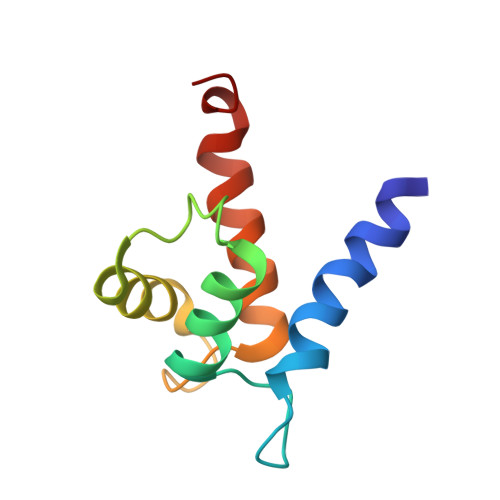A novel S100 target conformation is revealed by the solution structure of the Ca2+-S100B-TRTK-12 complex.
McClintock, K.A., Shaw, G.S.(2003) J Biological Chem 278: 6251-6257
- PubMed: 12480931
- DOI: https://doi.org/10.1074/jbc.M210622200
- Primary Citation of Related Structures:
1MQ1 - PubMed Abstract:
The Alzheimer-linked neural protein S100B is a signaling molecule shown to control the assembly of intermediate filament proteins in a calcium-sensitive manner. Upon binding calcium, a conformational change occurs in S100B exposing a hydrophobic surface for target protein interactions. The synthetic peptide TRTK-12 (TRTKIDWNKILS), derived from random bacteriophage library screening, bears sequence similarity to several intermediate filament proteins and has the highest calcium-dependent affinity of any target molecule for S100B to date (K(d) <1 microm). In this work, the three-dimensional structure of the Ca(2+)-S100B-TRTK-12 complex has been determined by NMR spectroscopy. The structure reveals an extended, contiguous hydrophobic surface is formed on Ca(2+)-S100B for target interaction. The TRTK-12 peptide adopts a coiled structure that fits into a portion of this surface, anchored at Trp(7), and interacts with multiple hydrophobic contacts in helices III and IV of Ca(2+)-S100B. This interaction is strikingly different from the alpha-helical structures found for other S100 target peptides. By using the TRTK-12 interaction as a guide, in combination with other available S100 target structures, a recognition site on helix I is identified that may act in concert with the TRTK-12-binding site from helices III and IV. This would provide a larger, more complex site to interact with full-length target proteins and would account for the promiscuity observed for S100B target protein interactions.
- Department of Biochemistry and McLaughlin Macromolecular Structure Facility, the University of Western Ontario, London, Ontario N6A 5C1, Canada.
Organizational Affiliation:

















